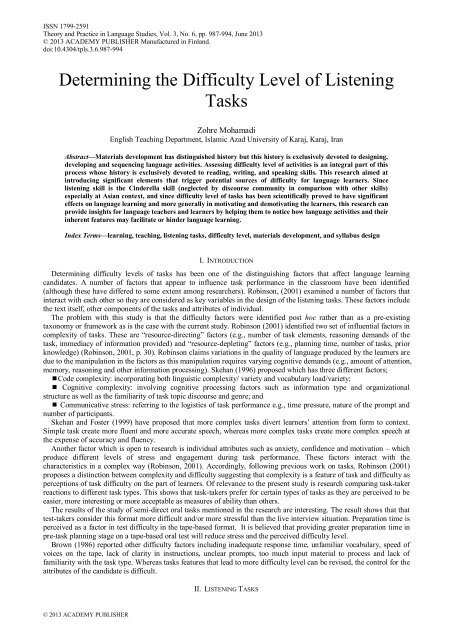Theory and Practice in Language Studies Contents - Academy ...
Theory and Practice in Language Studies Contents - Academy ...
Theory and Practice in Language Studies Contents - Academy ...
Create successful ePaper yourself
Turn your PDF publications into a flip-book with our unique Google optimized e-Paper software.
ISSN 1799-2591<strong>Theory</strong> <strong>and</strong> <strong>Practice</strong> <strong>in</strong> <strong>Language</strong> <strong>Studies</strong>, Vol. 3, No. 6, pp. 987-994, June 2013© 2013 ACADEMY PUBLISHER Manufactured <strong>in</strong> F<strong>in</strong>l<strong>and</strong>.doi:10.4304/tpls.3.6.987-994Determ<strong>in</strong><strong>in</strong>g the Difficulty Level of Listen<strong>in</strong>gTasksZohre MohamadiEnglish Teach<strong>in</strong>g Department, Islamic Azad University of Karaj, Karaj, IranAbstract—Materials development has dist<strong>in</strong>guished history but this history is exclusively devoted to design<strong>in</strong>g,develop<strong>in</strong>g <strong>and</strong> sequenc<strong>in</strong>g language activities. Assess<strong>in</strong>g difficulty level of activities is an <strong>in</strong>tegral part of thisprocess whose history is exclusively devoted to read<strong>in</strong>g, writ<strong>in</strong>g, <strong>and</strong> speak<strong>in</strong>g skills. This research aimed at<strong>in</strong>troduc<strong>in</strong>g significant elements that trigger potential sources of difficulty for language learners. S<strong>in</strong>celisten<strong>in</strong>g skill is the C<strong>in</strong>derella skill (neglected by discourse community <strong>in</strong> comparison with other skills)especially at Asian context, <strong>and</strong> s<strong>in</strong>ce difficulty level of tasks has been scientifically proved to have significanteffects on language learn<strong>in</strong>g <strong>and</strong> more generally <strong>in</strong> motivat<strong>in</strong>g <strong>and</strong> demotivat<strong>in</strong>g the learners, this research canprovide <strong>in</strong>sights for language teachers <strong>and</strong> learners by help<strong>in</strong>g them to notice how language activities <strong>and</strong> their<strong>in</strong>herent features may facilitate or h<strong>in</strong>der language learn<strong>in</strong>g.Index Terms—learn<strong>in</strong>g, teach<strong>in</strong>g, listen<strong>in</strong>g tasks, difficulty level, materials development, <strong>and</strong> syllabus designI. INTRODUCTIONDeterm<strong>in</strong><strong>in</strong>g difficulty levels of tasks has been one of the dist<strong>in</strong>guish<strong>in</strong>g factors that affect language learn<strong>in</strong>gc<strong>and</strong>idates. A number of factors that appear to <strong>in</strong>fluence task performance <strong>in</strong> the classroom have been identified(although these have differed to some extent among researchers). Rob<strong>in</strong>son, (2001) exam<strong>in</strong>ed a number of factors that<strong>in</strong>teract with each other so they are considered as key variables <strong>in</strong> the design of the listen<strong>in</strong>g tasks. These factors <strong>in</strong>cludethe text itself, other components of the tasks <strong>and</strong> attributes of <strong>in</strong>dividual.The problem with this study is that the difficulty factors were identified post hoc rather than as a pre-exist<strong>in</strong>gtaxonomy or framework as is the case with the current study. Rob<strong>in</strong>son (2001) identified two set of <strong>in</strong>fluential factors <strong>in</strong>complexity of tasks. These are ―resource-direct<strong>in</strong>g‖ factors (e.g., number of task elements, reason<strong>in</strong>g dem<strong>and</strong>s of thetask, immediacy of <strong>in</strong>formation provided) <strong>and</strong> ―resource-deplet<strong>in</strong>g‖ factors (e.g., plann<strong>in</strong>g time, number of tasks, priorknowledge) (Rob<strong>in</strong>son, 2001, p. 30). Rob<strong>in</strong>son claims variations <strong>in</strong> the quality of language produced by the learners aredue to the manipulation <strong>in</strong> the factors as this manipulation requires vary<strong>in</strong>g cognitive dem<strong>and</strong>s (e.g., amount of attention,memory, reason<strong>in</strong>g <strong>and</strong> other <strong>in</strong>formation process<strong>in</strong>g). Skehan (1996) proposed which has three different factors;Code complexity: <strong>in</strong>corporat<strong>in</strong>g both l<strong>in</strong>guistic complexity/ variety <strong>and</strong> vocabulary load/variety; Cognitive complexity: <strong>in</strong>volv<strong>in</strong>g cognitive process<strong>in</strong>g factors such as <strong>in</strong>formation type <strong>and</strong> organizationalstructure as well as the familiarity of task topic discourse <strong>and</strong> genre; <strong>and</strong> Communicative stress: referr<strong>in</strong>g to the logistics of task performance e.g., time pressure, nature of the prompt <strong>and</strong>number of participants.Skehan <strong>and</strong> Foster (1999) have proposed that more complex tasks divert learners‘ attention from form to context.Simple task create more fluent <strong>and</strong> more accurate speech, whereas more complex tasks create more complex speech atthe expense of accuracy <strong>and</strong> fluency.Another factor which is open to research is <strong>in</strong>dividual attributes such as anxiety, confidence <strong>and</strong> motivation – whichproduce different levels of stress <strong>and</strong> engagement dur<strong>in</strong>g task performance. These factors <strong>in</strong>teract with thecharacteristics <strong>in</strong> a complex way (Rob<strong>in</strong>son, 2001). Accord<strong>in</strong>gly, follow<strong>in</strong>g previous work on tasks, Rob<strong>in</strong>son (2001)proposes a dist<strong>in</strong>ction between complexity <strong>and</strong> difficulty suggest<strong>in</strong>g that complexity is a feature of task <strong>and</strong> difficulty asperceptions of task difficulty on the part of learners. Of relevance to the present study is research compar<strong>in</strong>g task-takerreactions to different task types. This shows that task-takers prefer for certa<strong>in</strong> types of tasks as they are perceived to beeasier, more <strong>in</strong>terest<strong>in</strong>g or more acceptable as measures of ability than others.The results of the study of semi-direct oral tasks mentioned <strong>in</strong> the research are <strong>in</strong>terest<strong>in</strong>g. The result shows that thattest-takers consider this format more difficult <strong>and</strong>/or more stressful than the live <strong>in</strong>terview situation. Preparation time isperceived as a factor <strong>in</strong> test difficulty <strong>in</strong> the tape-based format. It is believed that provid<strong>in</strong>g greater preparation time <strong>in</strong>pre-task plann<strong>in</strong>g stage on a tape-based oral test will reduce stress <strong>and</strong> the perceived difficulty level.Brown (1986) reported other difficulty factors <strong>in</strong>clud<strong>in</strong>g <strong>in</strong>adequate response time, unfamiliar vocabulary, speed ofvoices on the tape, lack of clarity <strong>in</strong> <strong>in</strong>structions, unclear prompts, too much <strong>in</strong>put material to process <strong>and</strong> lack offamiliarity with the task type. Whereas tasks features that lead to more difficulty level can be revised, the control for theattributes of the c<strong>and</strong>idate is difficult.II. LISTENING TASKS© 2013 ACADEMY PUBLISHER
















